2013 | Forum Expanded
In-Between the Images
One of the festival's greatest highlights this year promises to be a projection in the Berliner Liquidrom which forms part of the Forum Expanded. In addition, the group exhibition is taking place in Wedding's former crematorium. Curator Stefanie Schulte Strathaus about conquering space, how particles desire to form a wave and phone calls from outer space.
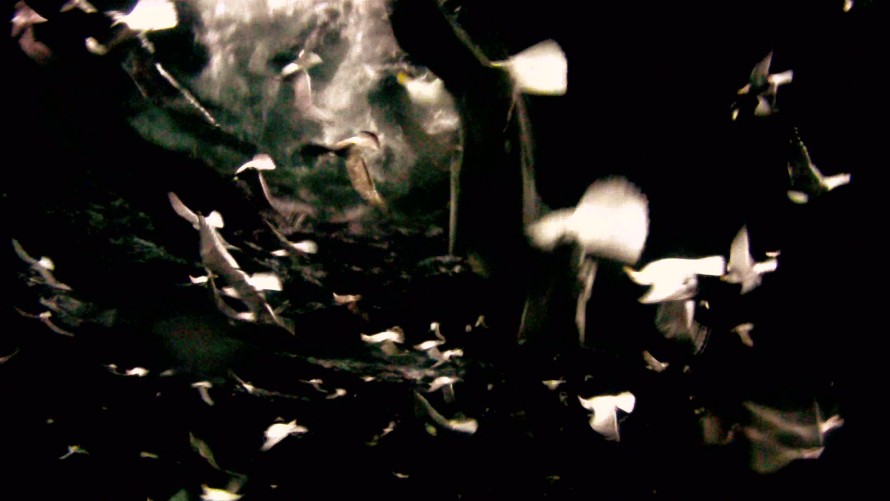
Leviathan by Lucien Castaing-Taylor und Véréna Paravel
For the first time the group exhibition is taking place in Wedding's former crematorium. What kind of atmosphere did you encounter there and did everyone find it inspiring from the start?
Yes, the location is a former crematorium. It is now known as the "Silent Green Kulturquartier". The space has been taken over in order to create a centre for culture. We're the first people to put on an exhibition there. It hasn't been used as a crematorium for years but there is still a sense of tranquility: it is a place of remembrance and contemplation. The building is really intriguing, especially for the artists who had very different reactions to it from the start – ranging from total fascination to declaring it utterly impossible. However, they are all very happy now.
Has the building's history had an impact upon the artists' works or did you only invite pieces which were already completed?
Most of the works were already complete but we paid a lot of attention during the selection process to what it means for them to be shown in a former crematorium. The video installations naturally alter the space, bringing in different colours and movement. However, there is one big work which is actually site specific: Lucien Castaing-Taylor's and Véréna Paravel's Canst Thou Draw Out Leviathan With A Hook?. The two artists previously made Leviathan, a documentary about deep-sea fishermen. Just after they began filming, they lost every single camera in a storm at sea. After that, they fixed the cameras to the boat and the fishermen so it would be impossible to lose them again. This makes the viewer feel like they're really in the middle of the action, right inside the pictures. Fish fly towards the lens, waves break over the boat... it creates a totally sensory, physical cinematic experience.
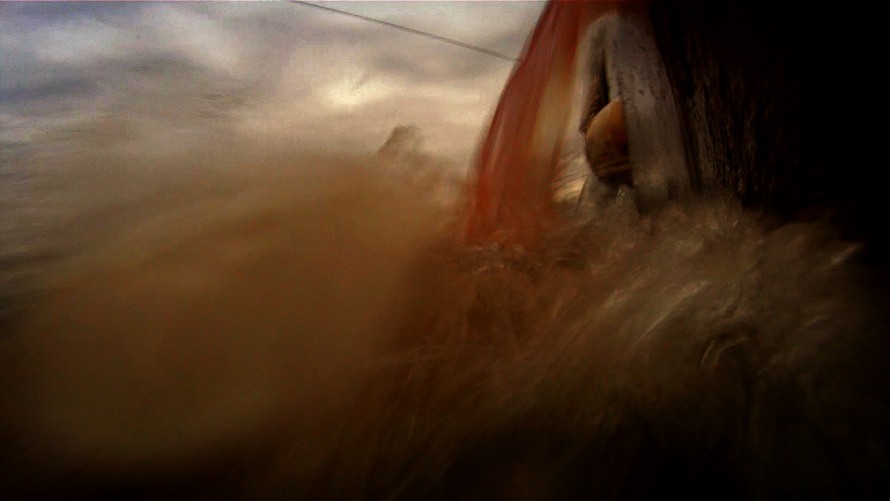
“Canst Thou Draw Out Leviathan With A Hook?“ by Lucien Castaing-Taylor and Véréna Paravel
After having watched the footage repeatedly in slow motion, the filmmakers discovered that new things became visible via the spray, the shimmering fish, the stars in the night sky, the lamps on the boat - things that I would call 'water and light' pictures. Ghosts appeared between the images which they then distilled through the arduous manipulation of individual frames. They began to stop seeing the film in a linear fashion and instead looked into its depths, drew diagonals through it and allowed individual frames to speak for themselves. When the artists heard the exhibition was taking place in a crematorium they developed an idea for an installation which plays with these different levels of cinematic perception. The film will also be shown in individual frames for two hours per day in Arsenal 2. By the end of the festival the entire film will have played there three times over which means you can really see the 'in-between the images'. We will also talk in a panel discussion about this phenomenon of ghosts creeping into films and telling us something more.
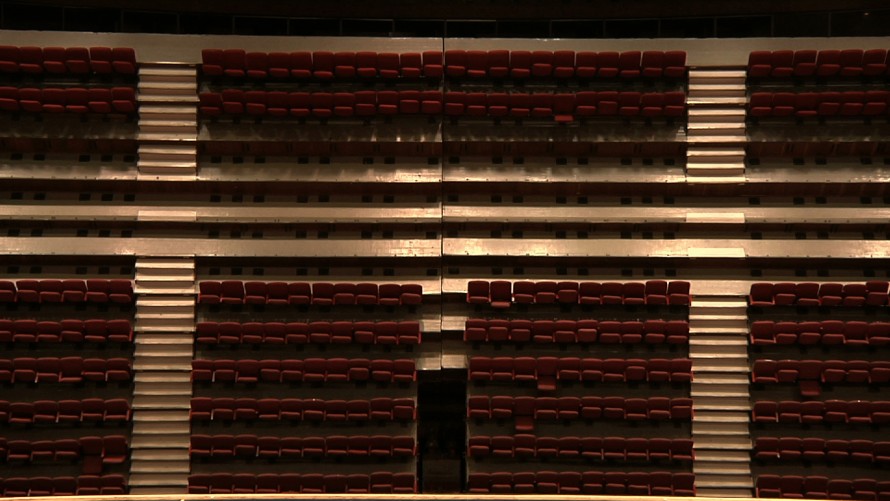
Bühne by Daniel Kötter
"Waves vs. Particles"
Daniel Kötter's film Bühne also focuses in its own particular way on architecture and the occupation of space...
In the beginning you see a huge stage in an auditorium which is very slowly - the movement is imperceptible at first - tilted over. There must be a gigantic motor because the stage turns through a full 180 degrees. Intercut with this are images which, seen on their own, do not reveal what they are about. It is a structural film which could be a cinematic experience in itself. However, the stage is in the main hall of the Palace of Sport and Culture in Varna in post-communist Bulgaria. The change in architecture also changes the space's social function. Depending upon the event taking place - whether sport or culture - the hall is completely redesigned or even turned upon its head. This naturally contains a strong symbolism.
Basically, the locations in almost all the pieces are extremely important: their individuality captures the universal. For this reason we have called the exhibition "Waves vs. Particles" because it is about the relationship between the particular and the entirety; the question of whether you can still have an individual existence when you are part of a whole; and the theory that this is simply a matter of perspective, as it is in physical experiments. All the pieces are very strongly situated within this subject area. Starting from a specific local setting they seek to make a more general analysis. When you look at all the works together - the films and installations - you can make out a political map drawing connections and interesting reference points between a world view and actual local political situations. However, they also harbour ghosts which could break out of such systems.
Are there any new waves or movements or does everything remain in the particular?
You're referring to political movements of the past and asking about political or aesthetic connections. Whatever the future may hold, I think there is currently a desire for a return to a greater solidarity. Of course the past is often romanticised. But I don't consider this a bad thing because it is not always about simply creating a detailed historical reconstruction. The question which fascinates me is: what interests me about the past and why? Then I can romanticise a little and select for myself the things which are relevant to the present. In doing this, we must of course keep in mind the multiplicity of this past as well as its details. This can and must change our view of the present.
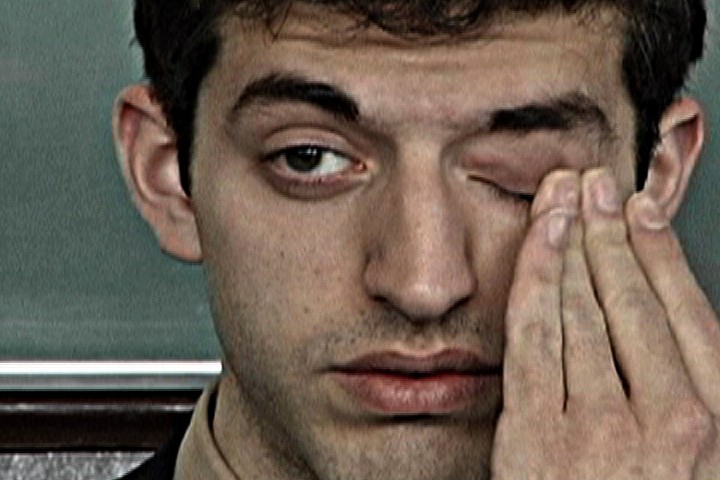
Once Every Day by Richard Foreman
One of your artists, Richard Foreman, grew up in a time when movements still existed. Is there any sense of this in his new film?
Richard Foreman was a key figure in the New York theatre and film scene of the late sixties and seventies. We will hold a panel discussion about this era with his contemporary, Babette Mangolte, who also has her own film in the programme (Edward Krasinski's Studio). We are screening Foreman's new film Once Every Day which he has made after a decades' long break. The film is very topical. It conveys a life experience, or the experience of actual perceptions formed by thought processes and internal blocks. These are revealed in theatre rehearsals via the directions, fragmentation and repetition and therein lies the cinematic aspect of the piece. I don't think it is a coincidence that Foreman is now using the new technological possibilities to return to film in order to shed a different light on his theatre practice.
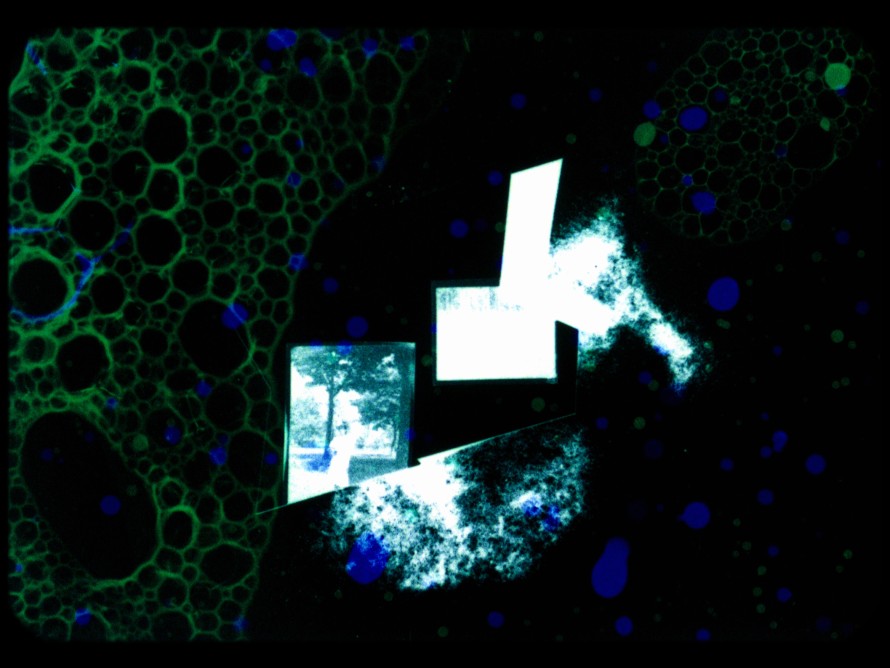
Blinder Fleck by Björn Speidel
Materiality, Content and References
We have spoken about the conquering of space via the medium, which means art is extending into social reality. At the same time, the programme devotes itself to strongly self-reflexive experimentation. Do these two tendencies contradict or complement one another?
These are not contradictory things. Structural works like Björn Speidel's Blinder Fleck or Lucy Raven's RP31 scrutinise the terms of perception and that is actually something we should always do when approaching social, societal or political topics. In addition, both films deal with something very concrete: the image itself. In RP31 these are the colour testcards which we are all familiar with but which are being lost alongside analogue film. Raven emphasises their normalising function which also exists in the digital age but which is more hidden and hence has the potential to be much more dangerous.
Blinder Fleck is about family photos or more generally photo archives which can only be perceived as fragments and shadows. The images and the medium can no longer be distinguished from each other. Both works pose the question: what do we see and under which conditions?
One of your key focuses is on the Brazilian artist Hélio Oiticica. But there is a documentary of the same name about him screening in the Forum. Why is that?
Forum Expanded is actually part of the Forum and has developed out of it. The work of the late Brazilian artist Hélio Oiticica - who died in 1980 - is an overarching topic which we are tackling in both sections. On the one side there is the documentary and on the other the installations and unknown film material. Oiticica's art is very well-known but his Super-8 films have hardly been seen. He was associated with the New York Underground scene of the 1970s which we have already frequently focused upon – for example with Mario Montez, Jack Smith and Andy Warhol. Oiticica filmed a lot of Super-8 footage at that time and this material has become part of the documentary. In Forum Expanded we are presenting a selection of the material itself alongside Super-8 films from other artists in which Oiticica appears. In addition, there will be a panel discussion with Sabeth Buchmann and Max Jorge Hinderer Cruz who are publishing a book about Oiticica.
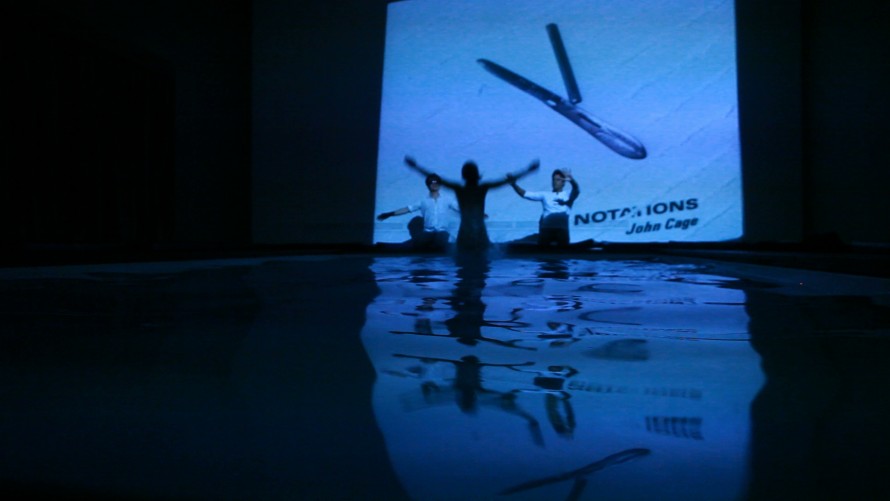
CC4 Nocagions by Hélio Oiticica und Neville D'Almeida
"Quasi Cinema"
What does the term "Quasi Cinema", coined by Oiticica, actually mean?
He believed television would supersede cinema. This poses many questions which Forum Expanded is also addressing. Cinema is not dying but just changing massively and stepping outside the auditorium. Rather than speaking about the death of cinema, we need to develop a new definition of what it actually is. Cinema's designated function as a social meeting place is growing more and more rare. But cinema can continue to exist in other forms. Oiticica already recognised this and developed it in the Cosmococa installation. Here, he laid out patterns of cocaine on record sleeves and catalogue covers and then created slides out of them which he arranged in an installation. The work is very much about the relationship between single images and moving within a social space which he specifically designed. We are showing one of the pieces, CC6, in the Hamburger Bahnhof Museum of Contemporary Art which sticks very closely to the instructions Oiticica left behind for the presentation of the work.
Yes, and that's why it can be seen for one night only. In this case we have been very free with Oiticicas' instructions. Part of his idea was that you should see the installation from the water but he specified ice-cold water and we only have very warm saltwater. To truly experience the installation, you have to bring a swimsuit and lie in the water. You will see the projection on the Liquidrom's cupola and hear John Cage underwater. In the Hamburger Bahnhof we have a type of reconstruction whereas in the Liquidrom we are being relatively free with the artist's instructions. They are two very different approaches, two ways of dealing with history, but both are legitimate in their own way. These issues can be elaborated upon during the panel discussion.
Forum Expanded seeks to build a bridge between the moment of the premiere, the event, which comes along with the Berlinale - and which is very important in getting the perception underway - and the associated discourse. In everything we do, we always want to consider the questions: why are we doing this? Who will find it interesting? And how do we present it? These things are often hard to reconcile but in the context of the Oiticica project the synthesis works.
The presentation of the CC4 installation in the Berliner Therme Liquidrom, however, goes far beyond the usual presentation format for cinematic installations...
Yes, and that's why it can be seen for one night only. In this case we have been very free with Oiticicas' instructions. Part of his idea was that you should see the installation from the water but he specified ice-cold water and we only have very warm saltwater. To truly experience the installation, you have to bring a swimsuit and lie in the water. You will see the projection on the Liquidrom's cupola and hear John Cage underwater. In the Hamburger Bahnhof we have a type of reconstruction whereas in the Liquidrom we are being relatively free with the artist's instructions. They are two very different approaches, two ways of dealing with history, but both are legitimate in their own way. These issues can be elaborated upon during the panel discussion.
Forum Expanded seeks to build a bridge between the moment of the premiere, the event, which comes along with the Berlinale - and which is very important in getting the perception underway - and the associated discourse. In everything we do, we always want to consider the questions: why are we doing this? Who will find it interesting? And how do we present it? These things are often hard to reconcile but in the context of the Oiticica project the synthesis works.
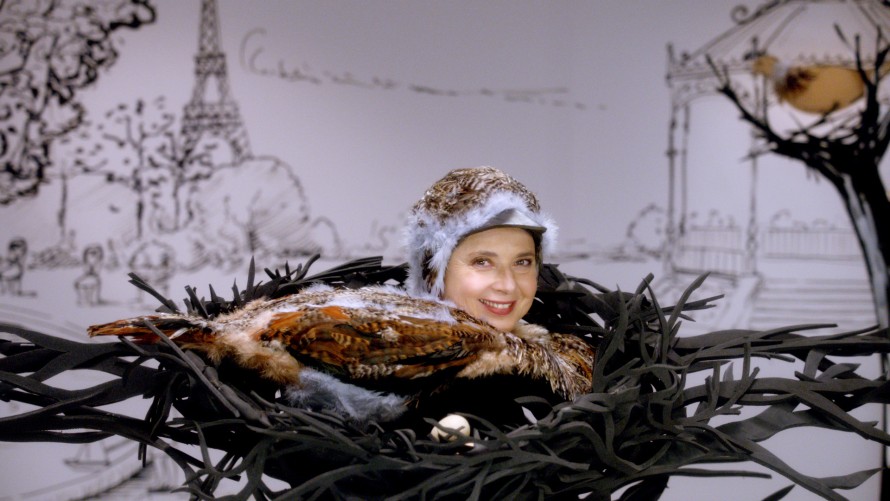
Mammas by Isabella Rossellini
Someone who wonderfully incorporates the balancing act between the event and the critical analysis is Isabella Rossellini. That is why we are delighted that, with her 20 minute short film series Mammas, she is once again appearing in Forum Expanded. The series is a very pointed but also extremely witty interrogation of the mothering instinct myth. Isabella Rossellini plays all the roles herself. Her skill in combining the event and its analysis means she could almost be designated the section's figurehead.
One final question: Pipe Dreams focuses on Syria. Are there actually any images today from Syria which don't feature war and destruction
The film is set in outer space. There was a cosmonaut on a Russian space mission who, whilst in orbit, phoned the then President Hafez al-Assad. The conversation is unbelievable. What do you talk about with a president when you are in outer space? It is very obvious that the questions and answers were carefully scripted in advance. The result is of course pure propaganda. And totally fascinating. Material from the country's recent past has been added and you can see a statue of Assad being dismantled in order to protect it from demonstrators. A critique from outer space.